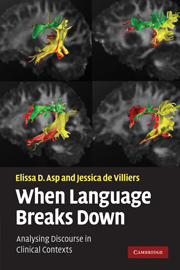Book contents
- Frontmatter
- Contents
- List of figures
- List of tables
- Acknowledgements
- Transcription conventions
- Introduction
- 1 Introduction to clinical discourse analysis
- 2 Theoretical and clinical contexts
- 3 Talk and speech – conversation analysis and intonation in English
- 4 Grammar
- 5 Phase and contexts of culture and situation
- 6 Study design
- 7 Differential diagnosis and monitoring
- 8 Cognitive models, inferencing and affect
- 9 Modelling information across domains
- Closing remarks
- Notes
- Appendix A Some basic grammatical terminology and relations
- Appendix B Inventory of codes
- References
- Author index
- Subject index
1 - Introduction to clinical discourse analysis
Published online by Cambridge University Press: 05 June 2012
- Frontmatter
- Contents
- List of figures
- List of tables
- Acknowledgements
- Transcription conventions
- Introduction
- 1 Introduction to clinical discourse analysis
- 2 Theoretical and clinical contexts
- 3 Talk and speech – conversation analysis and intonation in English
- 4 Grammar
- 5 Phase and contexts of culture and situation
- 6 Study design
- 7 Differential diagnosis and monitoring
- 8 Cognitive models, inferencing and affect
- 9 Modelling information across domains
- Closing remarks
- Notes
- Appendix A Some basic grammatical terminology and relations
- Appendix B Inventory of codes
- References
- Author index
- Subject index
Summary
Discourse represents that aspect of mental activity that most clearly reflects the intimate and over-lapping connections among cognition, language, and communication.
(Ulatowska et al. 1985)What is clinical discourse analysis?
Clinical discourse analysis is the term we use to describe the analysis of language behaviour observed in clinical contexts. Language behaviour includes well-defined areas of clinical research addressing syntax, vocabulary, phonology, conversation skills and cohesion. It also includes areas less commonly described in clinical research such as argument roles, situational features and functional variation. The focus of clinical discourse analysis is natural language behaviour which requires examination of all these aspects of language use. Even the smallest of texts require analysis that can explore multivariate features.
Consider the following sentence:
(1) I can remember my Mom.
It is extracted from a brief sample of spoken discourse elaborated below. The sentence has an interactional function: it makes a statement which is modalized for capacity (can). It has a predicate that references a cognitive process (remember) and two argument roles, an experiencer (I) and a percept (my mom). It has an unmarked clause order: subject occurs first in English statements unless there is a reason to emphasize some other element of structure. One might also assume that the speaker interprets the situation as an informal one in that she chooses to refer to her mother as Mom rather than mother.
- Type
- Chapter
- Information
- When Language Breaks DownAnalysing Discourse in Clinical Contexts, pp. 4 - 9Publisher: Cambridge University PressPrint publication year: 2010



